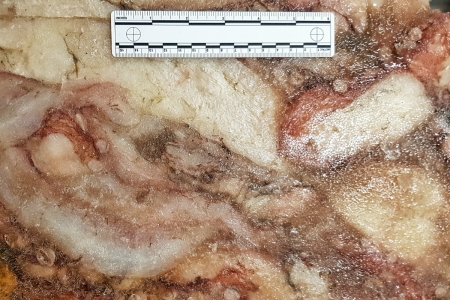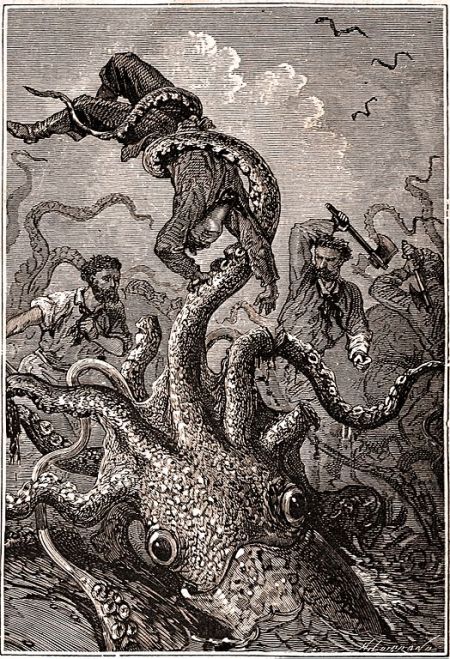Last week I gave you this new acquisition for the Dead Zoo to identify:

It’s a detail of something large, and it had a lot of you stumped because it looks like a cross between a marble worktop and pork terrine.
However, if you look closely at the bottom left of the image, you may just be able to make out the shape of a sucker-covered arm, because this – as spotted by palfreyman1414 and jennifermacaire – is a big cephalopod.
When I say big, I mean it’s the second largest species after the Colossal Squid (that I’ve talked about before) – that’s right, it’s a view of part of a large ice cube containing a Giant Squid Architeuthis dux Steenstrup, 1857.

Squid holding sailor by Alphonse de Neuville & Édouard Riou, from Hetzel edition of 20000 Leagues Under the Sea, p. 400.
This individual isn’t actually particularly giant, measuring in at a meagre 5.8m, including its long thin feeding tentacles – quite big, but hardly Kraken-esque. It was caught 118 miles off the Kerry coast after it found its way into shallower waters than the abyssal depths they normally inhabit. You can see details of how it was caught and a photo of the specimen on the Irish Times website.
I haven’t started the process of preserving for the long term yet, as it will require a bit of time to release the kraken from the ice, a large tank and some nasty chemicals – namely a 10% formalin solution and various strengths of Industrial Methylated Spirits (IMS – which is adulterated alcohol), stepping up to 70% in 10-20% increments. I may also need include an alkali buffer in the tank (marble chips are commonly used) since Giant Squid use ammonium chloride in their tissues to increase their buoyancy and that can acidify the solution, leading to accelerated bleaching of the tissues and long-term damage to the specimen.
Even with good preservation it’s unlikely to ever go on display as a full specimen. I can probably find a big enough jar, but the specimen has been dissected and isn’t really looking its best. However, it may be worth showing some of the elements, like an eye, the beak or maybe an arm or tentacle. These may be in good enough condition to use on display to explain some of the interesting features of these denizens of the deep. The rest of the squid will be there for researchers interested in these large, but elusive, molluscs.

Lovely stuff. Certainly hope at least one of the eyes can be turned into a public-facing exhibit. They’re magnificent, plus they have their optic nerves the right way around.
first time i saw a humboldt squid i felt like i’d found the kraken, but a nearly 6m ‘shorty’… life is amazing!
Thank you for the details of the preservation! Not that I will ever have the experience of preserving one, but the ammonium chloride fact was new to me.
Pretty cool